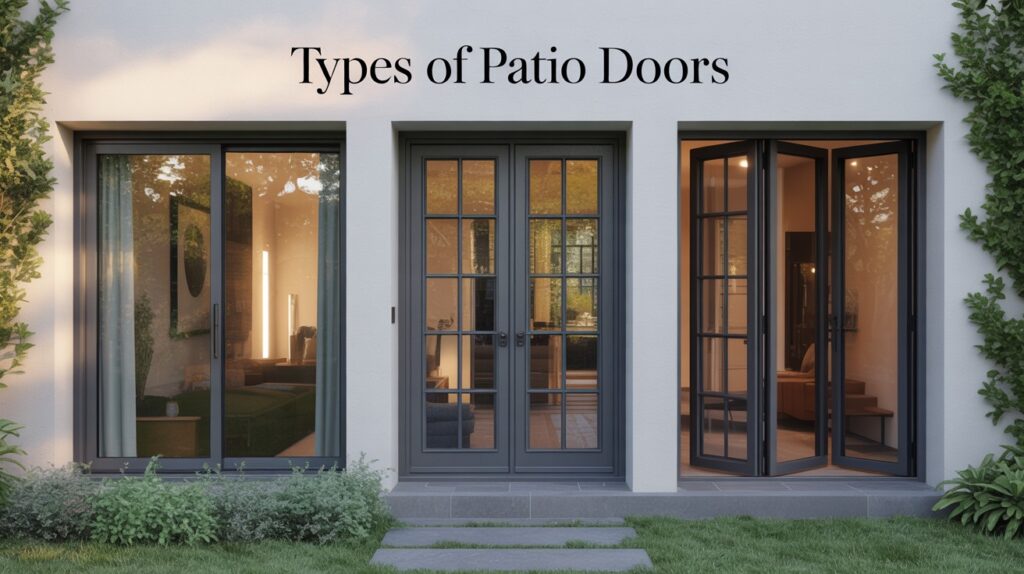Patio doors connect your indoor and outdoor spaces, allowing you to seamlessly transition between them. They bring in natural light and fresh air while giving you easy access to your deck or yard. But here’s the thing, not all patio doors work the same way.
Some save space. Others make bold statements. And a few cost more than you might expect.
I’ve seen homeowners pick the wrong door style and regret it later. The door looked great in the showroom, but didn’t fit their lifestyle. You don’t want that to happen to you.
In this guide, I’ll show you seven different patio door types. You’ll learn what works well and what doesn’t. Additionally, I’ll share design tips that bring out the best in each style. By the end, you’ll know exactly which door fits your home and budget.
Types of Patio Doors
A comprehensive guide covering different patio door styles, including sliding, French, bi-fold, and pivot doors with their advantages, disadvantages, and design recommendations to help homeowners choose the best option for their space and lifestyle.
1. Sliding Glass Doors
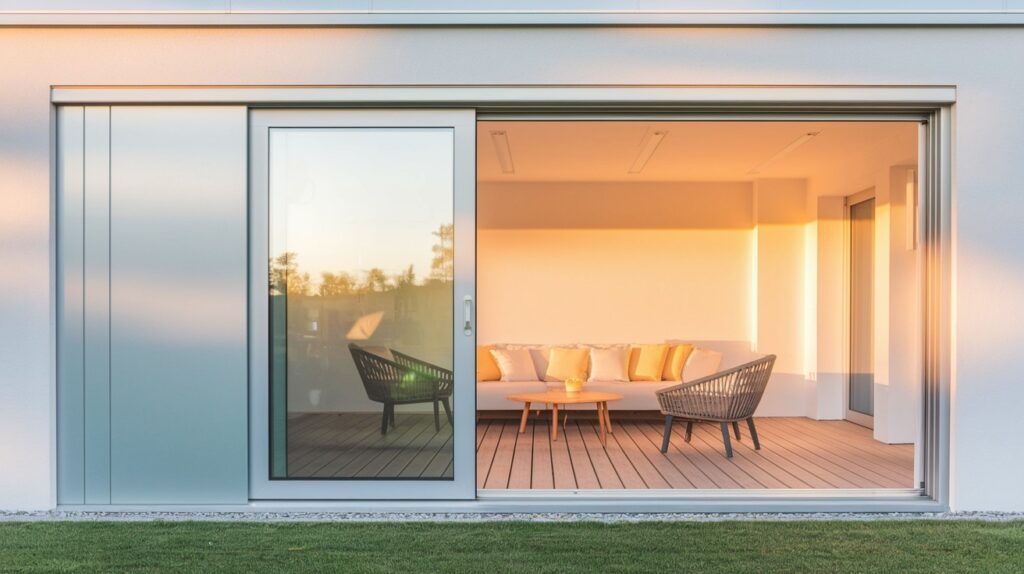
These doors slide sideways on tracks. One panel stays fixed while the other moves.
Pros:
- Save floor space since they don’t swing open
- Let in lots of natural light
- Costs less than most other options. Works well in tight spaces
Cons:
- Only half the door opens at once
- Tracks can collect dirt and jam
- Older models may not seal well
- Limited style options compared to other types
Design Idea: Add vertical blinds between the glass panels for a clean, modern look. Sheer curtains work too if you want softer light. Keep hardware simple and matching throughout the room.
2. French Patio Doors
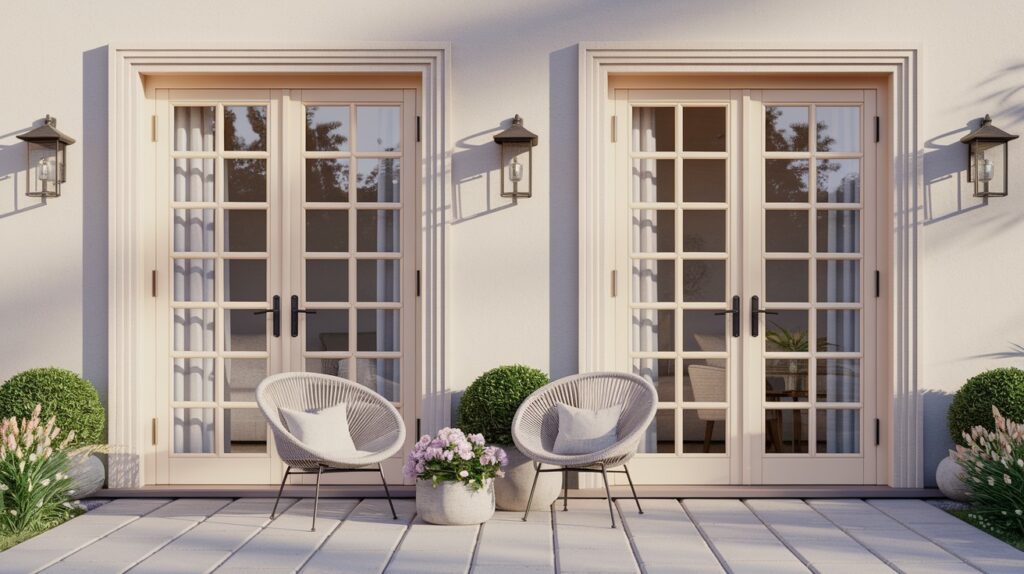
French doors have two panels that swing outward or inward. They often feature multiple glass sections divided by wooden or metal grids.
Pros:
- Open completely for wide access
- Bring classic charm to any home
- Available in many materials and finishes
- Create an open, airy feeling
Cons:
- Need a clear space to swing open
- May catch wind and slam shut
- More moving parts mean more maintenance
- Can be less energy-efficient than sliding doors
Design Idea: Choose wrought iron handles and hinges for a vintage feel. Divided glass panes add character. Paint the frames to match your home’s trim for a cohesive look.
3. Bi-Fold Patio Doors
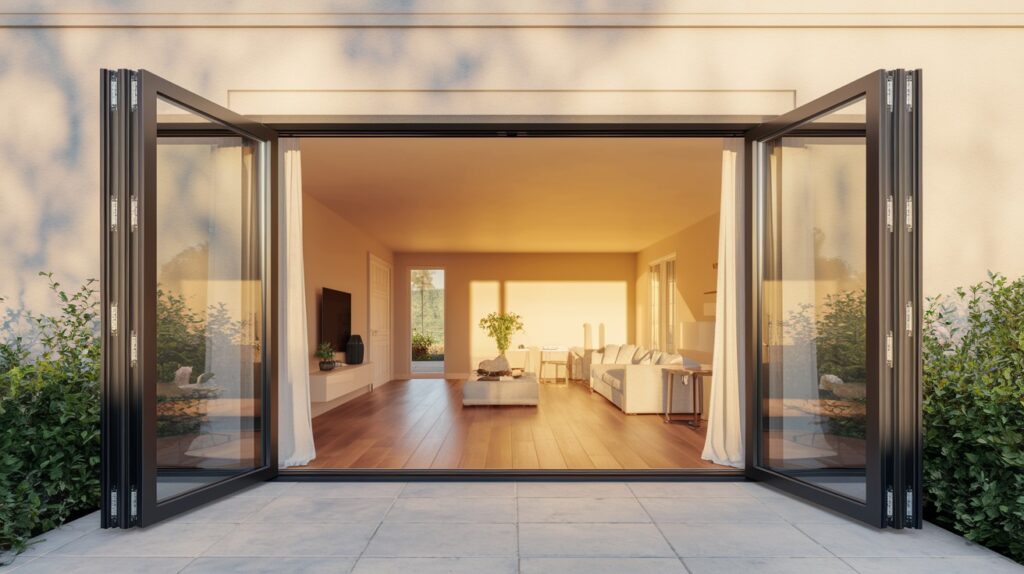
Bi-fold doors have multiple panels that fold accordion-style. They can open partially or completely.
Pros:
- Create huge openings when fully extended
- Perfect for connecting indoor and outdoor spaces
- Available with 2-8 panels
- Great for entertaining
Cons:
- Cost significantly more than basic sliding doors
- A complex installation requires professionals
- More hardware means more potential problems
- Heavy panels can be hard to operate
Design Idea: Use these in modern homes with open floor plans. They create that resort-style feeling where inside and outside blend. Choose dark frames for contemporary looks or wood for warmer styles.
4. Multi-Slide Patio Doors
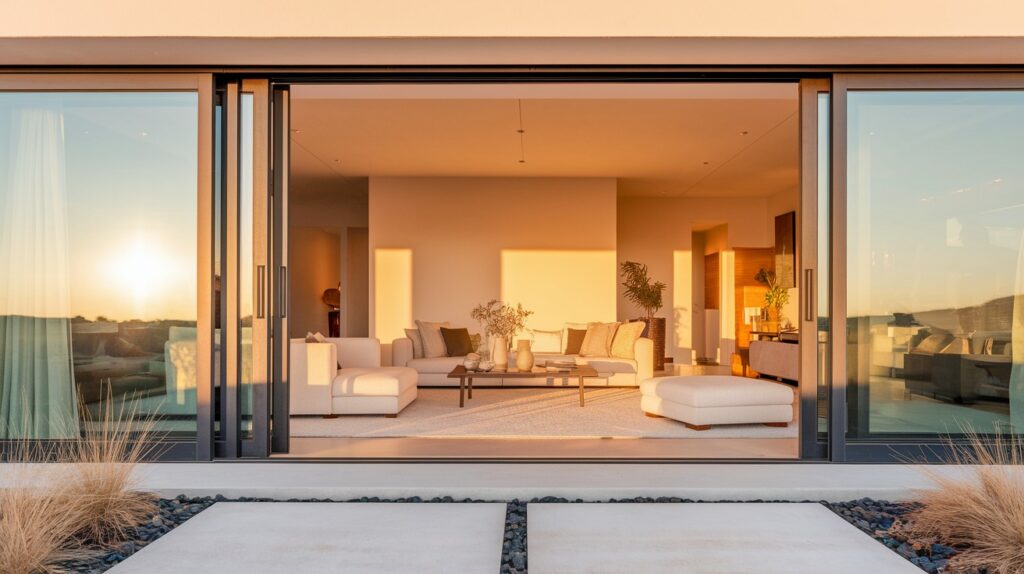
Multi-slide doors have several large panels that slide behind each other. Think of them as super-sized sliding doors.
Pros:
- Create impressive, grand openings
- Panels stack neatly to one side
- Can span very wide spaces
- Offer unobstructed views when open
Cons:
- Expensive, often the costliest option
- Professional installation required
- Heavy panels need strong framing
- Limited manufacturers and styles
Design Idea: These doors work best when you have beautiful outdoor views to showcase. Position them to frame your garden, pool, or landscape like artwork. Keep interior design minimal so the view stays the star.
5. Pivot Doors
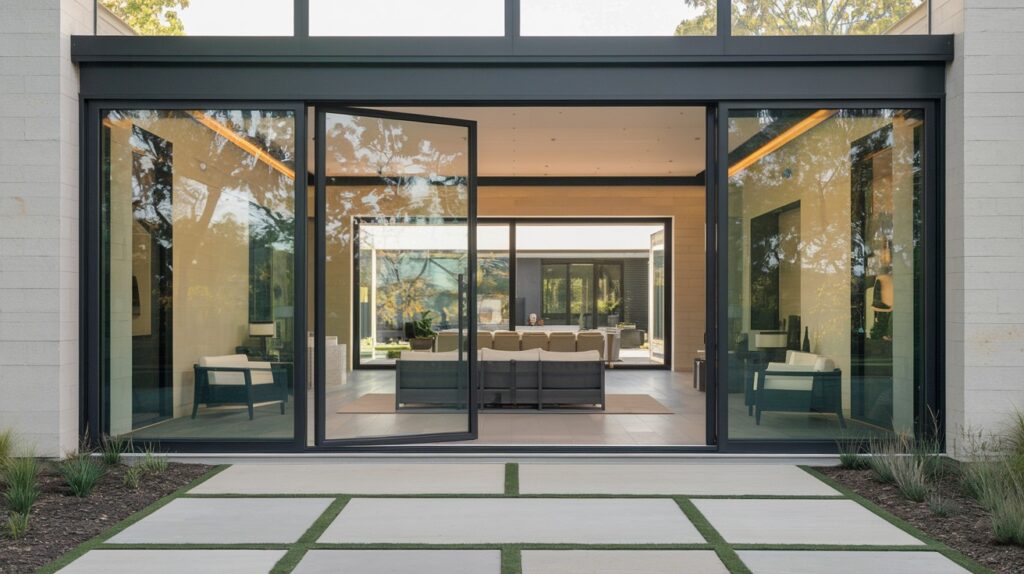
Pivot doors rotate on a central hinge instead of side hinges. They create a dramatic entrance effect.
Pros:
- Make a bold architectural statement
- Can be very large and impressive
- Smooth operation when properly installed
- Unique alternative to standard doors
Cons:
- Hard to find—few manufacturers make them
- Expensive custom installation
- May not work with standard door frames
- Limited hardware and glass options
Design Idea: Save these for ultra-modern homes with clean lines and bold features. They work best as single, large panels in glass or wood. Keep the surrounding design simple to let the door be the focal point.
6. Swinging Single Patio Doors
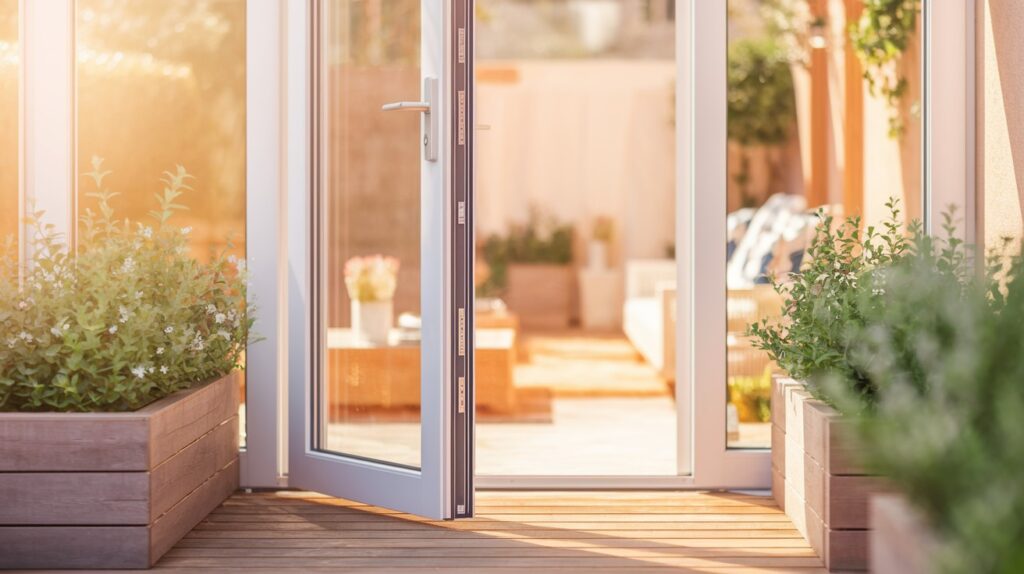
These are regular doors that swing in or out, just like your front door, but with more glass.
Pros:
- Simple and straightforward
- Most affordable option
- Easy to install and repair
- Work with standard door frames
Cons:
- Smaller opening than double doors
- A less dramatic visual impact may look plain compared to other styles
- Limited light compared to larger doors
Design Idea: Add sidelights (narrow windows) on each side for more light and visual interest. Transom windows above the door also help. Choose decorative hardware that matches your home’s style.
7. Dutch Patio Doors
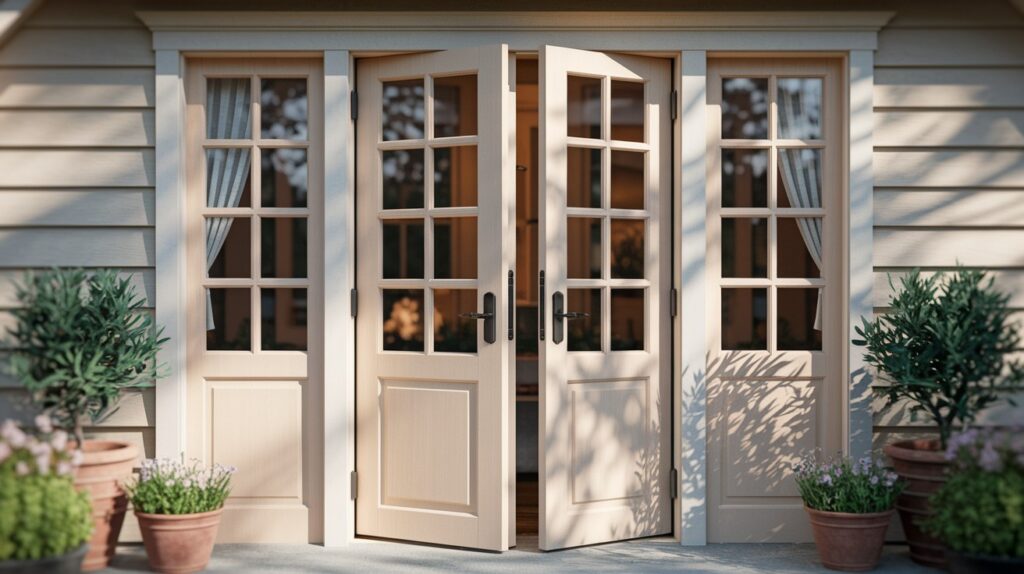
Dutch doors split horizontally in the middle. You can open the top half independently from the bottom half.
Pros:
- Let in air while keeping pets inside
- Add country charm and character
- Flexible—open top, bottom, or both
- Great conversation starter
Cons:
- Less secure than solid doors
- May not seal well in harsh weather
- Limited modern style options
- Harder to find and more expensive
Design Idea: These doors shine in farmhouse or cottage-style homes. Paint them in bright colors like red, blue, or green. Add flower boxes underneath for extra charm.
Tips for Choosing the Right Patio Door
Your home’s style should guide your choice. Ranch homes look great with sliding doors. Victorian houses suit French doors better.
Think about your climate, too.
Cold areas need doors with good insulation. Windy locations require strong latches and weatherstripping.
Consider how you’ll use the space. Do you entertain often? Wide-opening doors work better. Need to save space? Go with sliding options.
Don’t forget about these important features:
- Double or triple-pane glass for energy savings
- Quality locks for security
- Screens for bug-free fresh air
- Window treatments for privacy
Your budget matters too. Basic sliding doors start around $300. High-end multi-slide systems can cost $10,000 or more.
Conclusion
The right patio door changes how you live in your home. It brings light, connects you to your outdoor space, and adds real value to your property.
Sliding doors work great for small spaces and tight budgets. French doors add classic style and wide openings. Bi-fold and multi-slide options create impressive indoor-outdoor connections but cost more.
Think about your lifestyle first. Then match the door style to your home’s architecture and your budget.
Remember, this is a long-term investment. You’ll live with your choice for many years. Take time to consider all your options. Visit showrooms. Touch the hardware. Test how smoothly they operate.
The perfect patio door is out there waiting for you.
Frequently Asked Questions
What is the most energy-efficient type of patio door?
Sliding and multi-slide doors with double or triple-pane glass and weather stripping are among the most energy-efficient. Look for doors with low-E coatings and insulated frames for the best performance.
Are French doors more secure than sliding doors?
French doors can be more secure with quality locks and reinforced glass. However, modern sliding doors also come with advanced locking systems. Security depends more on the quality of hardware than the door style.
Can I install patio doors myself?
Basic doors like sliding or single swing types can be DIY-friendly if you have experience with home improvement. However, bi-fold and pivot doors usually require professional installation due to their complexity.
What’s the best patio door for small spaces?
Sliding doors are the top choice for tight areas since they don’t swing open and save floor space. They give you access to the outdoors without taking up valuable interior space.
Do patio doors add value to a home?
Yes! Stylish and functional patio doors enhance natural light, curb appeal, and indoor-outdoor living—all features that buyers value. Quality doors typically return 60-80% of their cost at resale.

